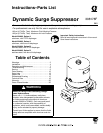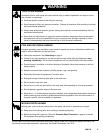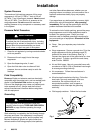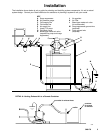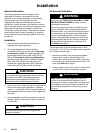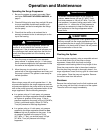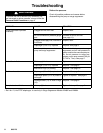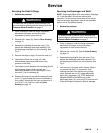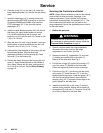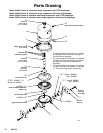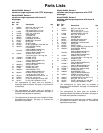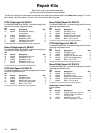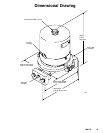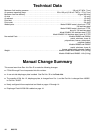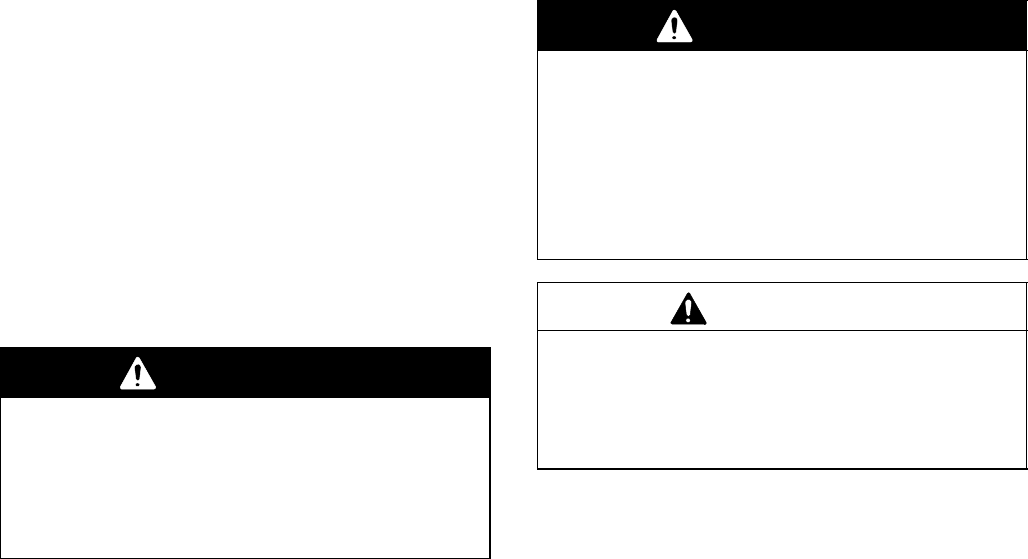
7
308178
Operation and Maintenance
Operating the Surge Suppressor
1. Be sure the system is properly grounded. Read
and follow FIRE AND EXPLOSION HAZARD, on
page 3.
2. Check all fittings to be sure they are tight. Be sure
to use a compatible liquid thread sealant on all
male threads, and do not overtighten the fittings
into the pump.
3. Check that the muffler or air exhaust line is
securely connected to the air exhaust port on the
top of the housing.
WARNING
Never operate the surge suppressor without the
muffler or an air exhaust line installed in the air
exhaust port. If the air exhaust port is left open and
the diaphragm shaft works loose from the bolt, the
shaft could be propelled out of the housing, caus-
ing injury.
4. Start the pump as explained in your separate
pump manual. In systems using a 1:1 ratio pump,
the air pressure supplied to the suppressor will be
the same as that supplied to the pump.
5. Allow the pump to cycle slowly until all air is
pushed out of the surge suppressor and lines, and
the pump is primed. The system is now ready for
normal operation.
NOTES:
When using a pump with a ratio greater than 1:1, the
air pressure supplied to the surge suppressor and the
air pressure supplied to the pump must be at the same
ratio as the pump to prevent overpressurization of the
surge suppressor. See the following examples.
D In a system using a 2:1 ratio pump, air pressure
supplied to the surge suppressor should be twice
as high as air pressure to the pump. If the air
pressure supplied to the pump is 50 psi (0.34 MPa,
3.4 bar), you should supply 100 psi (0.7 MPa,
7 bar) air pressure to the surge suppressor.
D In a system using a 4:1 ratio pump, air pressure
supplied to the surge suppressor should be four
times as high as air pressure to the pump. If the
air pressure supplied to the pump is 25 psi
(0.17 MPa, 1.7 bar), you should supply 100 psi
(0.7 MPa, 7 bar) air pressure to the surge
suppressor.
WARNING
To prevent overpressurization of the surge sup-
pressor, never exceed 100 psi (0.7 MPa, 7 bar)
fluid inlet pressure or 100 psi (0.7 MPa, 7 bar) air
inlet pressure. In systems using pumps with a ratio
greater than 1:1, reduce the air inlet pressure to
the pump as necessary to keep the fluid and air
inlet pressures to the surge suppressor within
these limits.
CAUTION
In systems using pumps with a ratio greater than 1:1,
fluid may escape into the surge suppressor air line
and contaminate the air supply if the diaphragm fails.
Installation of a check valve in the air line will prevent
fluid contamination of the air line.
Flushing the System
Flush the system regularly, using a compatible solvent.
Do not allow fluid to dry in the pump or surge
suppressor. Always flush the pump and surge
suppressor before storing them for any length of time.
Place the pump suction tube in the solvent container.
Run the pump long enough to thoroughly clean it, the
surge suppressor, hoses, and any guns or valves used
in the system. Close the pump air regulator. Remove
the suction hose from the solvent.
Shutdown
Remove the suction hose from the fluid container and
run the pump until the fluid is forced out of the system.
Then shut off the air supply immediately.



